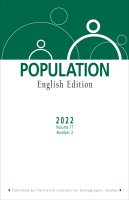
Population 2022, n2
2022
The Dead Ends of Sociogenomics
Nicolas Robette
Chinese Immigration to France
Isabelle Attané
Demography, Peasantry, and Family in Early Medieval Provence, 813–814
Irene Barbiera, Maria Castiglioni, Gianpiero Dalla-Zuanna
Users of Homelessness Support Services in France in 2001 an d 2012: Contrasting Housing and Employment Trajectories
Pascale Dietrich-Ragon, Delphine Remillon
Educational Homogamy Across Generations: Effects on Inequalities in Living Standards in France
Pierre Courtioux, Vincent Lignon
The Dead Ends of Sociogenomics
Nicolas Robette
Beginning in the 2000s, high-throughput sequencing and genotyping technologies developed rapidly. This made it possible to study many genetic markers at once in many subjects, leading to the development of genome-wide association studies and polygenic risk scores. It is in this context of technological and statistical progress that sociogenomics, understood as the combination of sociology and genetics, appeared and spread within the social sciences. But the methods used by sociogenomicists are based on several conceptual and statistical presuppositions of doubtful validity. Independently of the limitations of the tools used, the results of sociogenomics research have contributed little to sociological and demographic knowledge. Studies in sociogenomics most often express a faith in the progress of the field through technical advancements, without questioning the biological model on which the entire enterprise is based. From this perspective, the sound of multiple calls for caution from learned societies in human genetics does not seem (yet) to have reached these
‘genetic entrepreneurs’ in the social sciences.
Chinese Immigration to France
Isabelle Attané
While still marginal across France as a whole, in terms of both stocks and flows, immigration from China has increased 6 times faster than that from other countries since the 1980s. This article aims to fill the quantitative knowledge gap on Chinese immigration. It begins by analysing census data to describe the main sociodemographic characteristics of Chinese immigrants with respect to those from other origins. Then, it uses administrative data to describe the inflows that have contributed to Chinese population increase in France, and to
estimate outflows. These analyses produce two main findings: first, a strong residential concentration in the Paris region (Île-de-France) and in the most urbanized areas; and second, large student inflows gradually modifying the general sociodemographic profile of Chinese migrants in France.
Demography, Peasantry, and Family in Early Medieval Provence, 813–814
Irene Barbiera, Maria Castiglioni, Gianpiero Dalla-Zuanna
Compiled in 813–814, the inventory of peasants working for the Abbey of Saint Victor in Marseille offers insights into the early medieval demographic dynamics of Provence (southern France). We reconstruct the population’s age structure and find it consistent with other European medieval registers. We also infer mortality— which closely resembles data on Provençal cemeteries of the first millennium and the standard life tables with high mortality for South Europe estimated by previous studies—and marriage and birth patterns. These results suggest that in early medieval Provence, demographic pressure had been higher than that observed in France and Western Europe after the Black Death. Finally, we analyse the way peasantry was settled and exploited in both flat and mountainous areas, clarifying the relationships between population settlements, environment, and production.
Users of Homelessness Support Services in France in 2001 an d 2012: Contrasting Housing and Employment Trajectories
Pascale Dietrich-Ragon, Delphine Remillon
Drawing on data from the INED–INSEE 2001 and 2012 Sans-domicile (homelessness) surveys, this article establishes a typology of the housing and employment trajectories of French-speaking users of homelessness support services. Most respondents are excluded from both the housing and employment markets. Some are actively looking for a job and a place to live, while others, such as migrants without work permits, appear trapped in limbo. Working but homeless respondents correspond to a particular profile: that of poor workers living in institutional accommodation. Our analysis of changes between 2001 and 2012 reveals the development of a three-tier accommodation system that partly overlaps with that of employment status: an emergency sector that takes in migrants and inactive single men; a stable housing sector for people with little or no shortterm prospect of rejoining the labour market but who belong to categories targeted by housing policies (people with disabilities, retirees, women); and a ‘social integration’ hostel sector that provides accommodation, generally on a temporary basis, for people in work or actively seeking employment.
Educational Homogamy Across Generations: Effects on Inequalities in Living Standards in France
Pierre Courtioux, Vincent Lignon
It is recognized that educational homogamy—the tendency for individuals to partner with someone with the same level of education—reinforces socio-economic inequalities within the population. However, published analyses generally exclude some of the oldest individuals to avoid generational bias. As such, the indicators produced are not directly comparable with the usual indicators of living standard inequalities calculated for the general population. This article proposes an original method for controlling for this generational bias in order to quantify the share of inequalities attributable to educational homogamy in the general population. Using logistic models of spousal matching probabilities by educational qualification, changes in education levels across generations are closely examined, as well as their role in the inequalities associated with educational homogamy. The results obtained from French data for the 2003–2013 period reveal that the impact of educational homogamy on inequalities in living standards is statistically significant but very slight. It affects
primarily the top of the living standards distribution and can only be demonstrated by controlling for generational effects.

